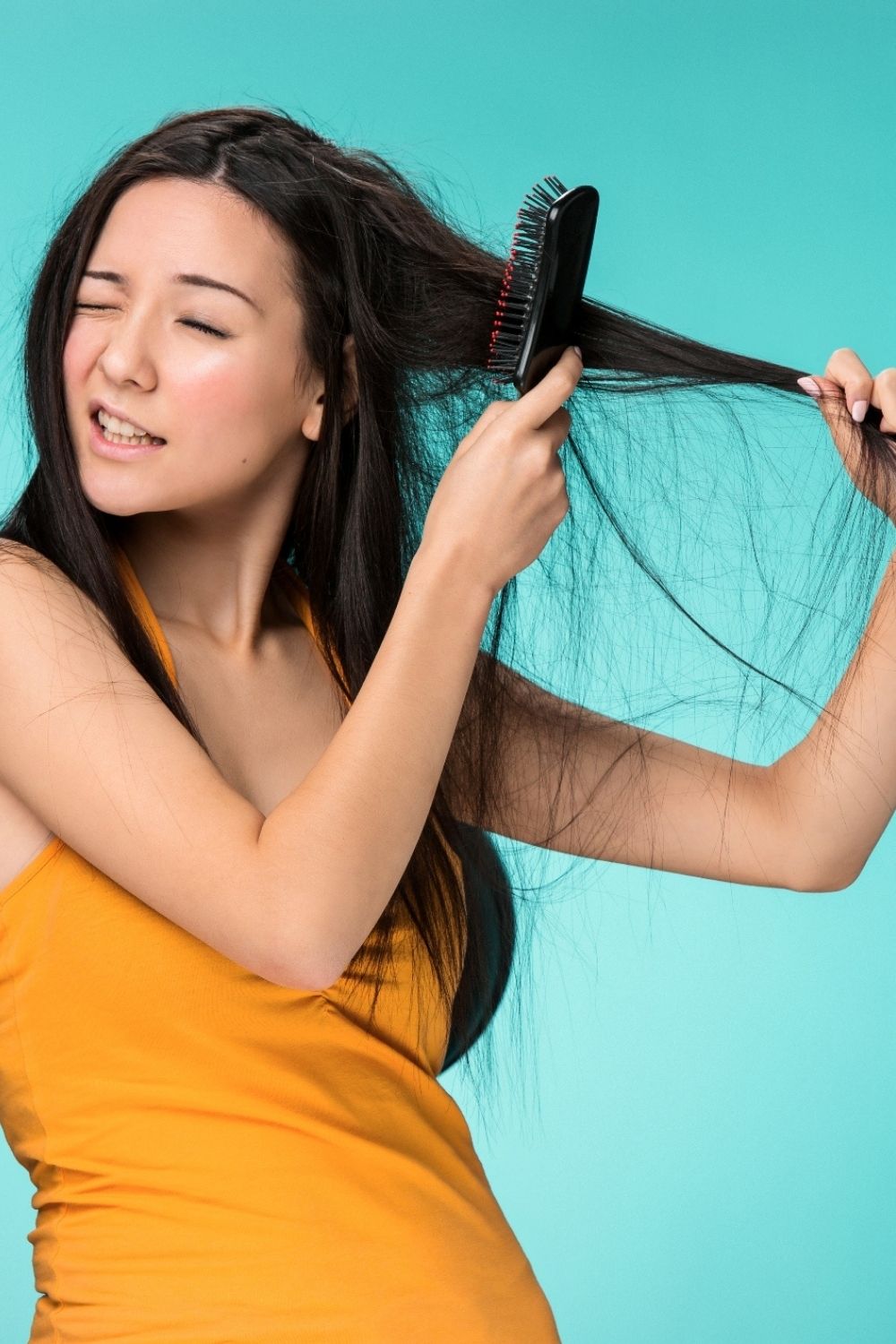Overprocessed hair is hair that has been damaged by:
- dye
- bleach
- heat
- other styling processes
When hair is overprocessed, your hair shaft becomes porous and dense, making it harder to style and maintain.
Overprocessed hair can’t be completely fixed. Damage to your hair shaft can’t be treated, since all visible hair on your head is technically dead cells.
However, there are steps you can take to significantly improve your hair’s appearance and make it easier to maintain while you wait for new hair to grow in.
Let’s take a look at the symptoms, causes, and treatments available for overprocessed hair.
What it looks like
Overprocessed hair will look different depending on your hair’s natural texture.
Typically, overprocessed hair looks and feels dry to the touch. It will lay in several directions and be prone to cowlicks and flyaways.
Overprocessed hair may also take on a different texture, or not have the same texture throughout. If you have natural or textured hair, you may notice this the most: Some pieces of hair may look straight while others look crimped or curly after too much processing.
Styling concerns
The most infamous sign of overprocessed hair has little to do with how it looks and is more about how you can’t get it to look. Overprocessed hair becomes notoriously hard to style.
Hair breakage can start to occur in areas where overprocessing has severely damaged hair. If overprocessing has burned your scalp, patches of your hair may fall out. Hair may also become “gummy.” This means that it feels thin and stringy.
If you have hair damage on the bottom, you may notice many split ends. Your hair may hang limp because of the split ends’ excess weight. This can give your hair an “uneven” appearance.
Finally, overprocessed hair may be more prone to looking “frizzy” or wild.
How to fix it
Hair that has been damaged can’t be restored to the way it looked before. But there are plenty of things you can do to make your hair easier to manage while you wait for new undamaged hair to grow in.
Natural remedies
You can try to treat overprocessed hair at home, sometimes with ingredients and products you already have. These methods are not backed by science, but anecdotally, some people have seen improvements in their hair with these remedies.
- Use a DIY or store-bought moisturizing hair mask. Your goal is to restore moisture and proteins that were removed from your hair shaft during processing. If you make your hair mask, choose a few ingredients like:
- honesy
- avocado
- raw egg
- bananas
- olive oil
- Switch up your styling routine. Let your hair air-dry mostly before you blow-dry for best results.
- Don’t use long-lasting hold styling products. Combing your hair after using this product can cause hair breakage and loss.
- Try to avoid using heat tools on your hair more than every other day. Also, try to keep the settings on low-to-medium. Too much heat can damage your hair.
- Try essential oils before bedtime. Use a moisturizing oil, like jojoba or almond oil, as a carrier oil to mix with an essential oil such as peppermint oil, which may stimulate hair growth. Do not use undiluted essential oil when applying to your hair. Apply just a few drops of the diluted essential oil to the ends of your hair and your scalp before you lay down for the night. You additionally should conduct a patch test prior to applying the essential oil mixture to insure you are not allergic to it. You may also want to apply coconut oil after a shower to seal moisture into your hair.
In the salon
- Get your ends trimmed. After processing, the ends of your hair can become like dead weight for the rest of your hair. Cutting a few inches of hair off can bring some bounce and texture back to your hair. Your stylist will know exactly how many inches need to be cut, so be prepared ahead of time to follow their advice.
- Try a salon-grade deep conditioner. Getting a deep conditioning treatment at the salon under your stylist’s supervision may be more effective than doing it yourself.
- Ask for a bond-building treatment, such as hair botox. While not scientifically proven to work, the idea is that the treatment restores broken links on the cellular level in your hair shaft. These treatments can be pricey, but many people swear by them.
One way that’s guaranteed not to fix overprocessed hair is to add another process on top of it. You may have to live with damaged hair for a little while as you wait for new growth to come in.
If you had your hair damaged at a salon, you should call and let your stylist know. You may be eligible for discounted or free services as your stylist works with you to make things right.
How to prevent it
The best treatment for overprocessed hair is to be proactive and try to prevent it from happening in the first place.
Prevention strategies include:
- Go to a responsible, professional stylist for any bleach or dye service. A licensed cosmetologist will be able to advise you on what your hair type can handle, and when it’s time to take a break from the bleach bottle.
- Let your hair air-dry whenever possible, especially if it’s color-treated.
- Be mindful of heat exposure, and try to limit your blow-dry or curling iron use to once or twice per week. Use a heat-protectant spray when you do style with heat.
- Limit your use of hair products that contain alcohol (such as hair sprays and mousse), as these can strip your hair of moisture and make damage more likely.
- The American Academy of Dermatology recommends stretching the time between coloring or bleaching sessions as much as you can, especially during dry, winter months. Try to leave 8 to 12 weeks between touch ups if you color or lighten your hair.
- Don’t double up on services or treatments that change the texture or look of your hair. For example, don’t try to perm your hair at the same time as you dye it. The American Academy of Dermatology also recommends doing the harsher process first and giving your hair 2 weeks to recover before layering more chemicals into the mix.
- Always use a shampoo and conditioner for your hair type, and make sure to condition after every wash.
- Remember that most people don’t have to wash their hair every day. So, cut back on hair washing and see if that helps.





